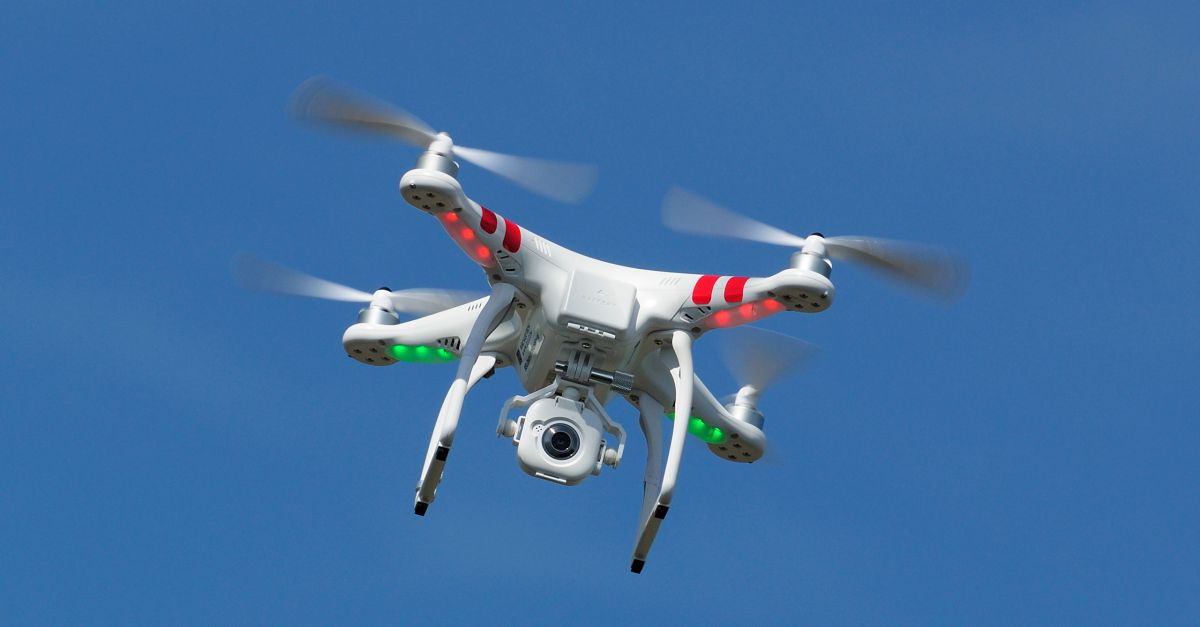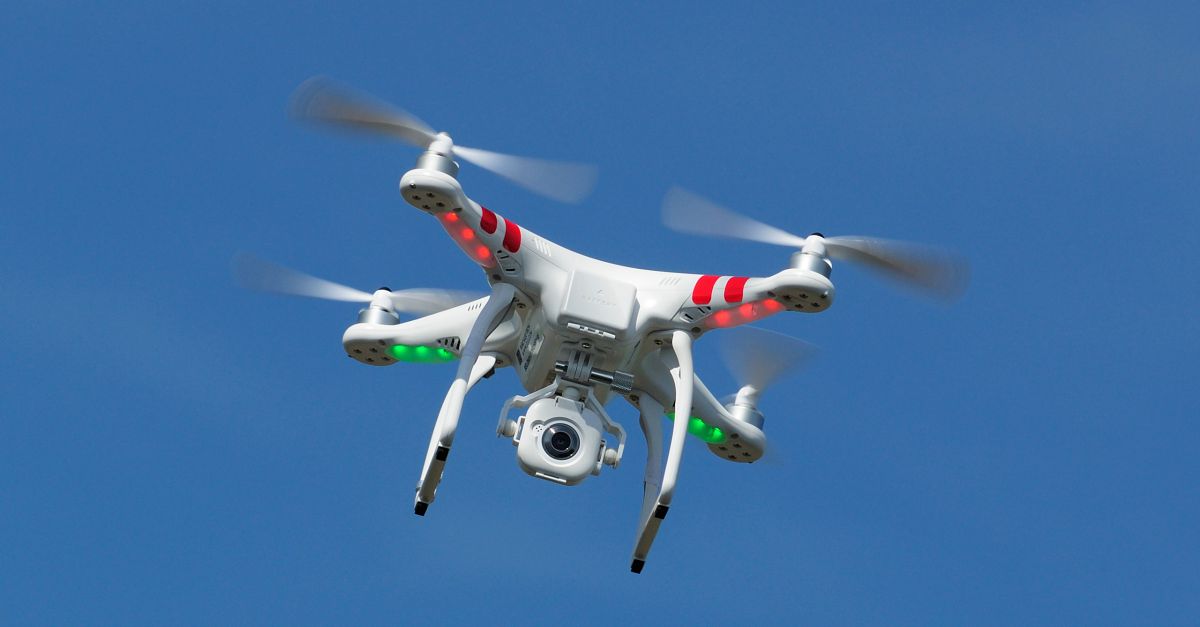
Wildfire roared over a Los Angeles area freeway that leads to Las Vegas on Friday, sending drivers running up a hill to get away, abandoning their cars behind them as they fled.
Some watched from the hill as smoke billowed and firefighters hosed down their cars to try to save them from burning.
What they didn’t see: helicopters dumping water buckets from above.
That’s because five drones flying close to the fire kept California firefighters from dispatching the helicopters for up to 20 minutes, as CNN reports.
This is the third time in recent weeks that drought-stricken California has been frustrated in fighting wildfire because of hobby drones flying in, presumably by people seeking video footage of dramatic scenes.
Another drone delayed efforts to battle a blaze in Mill Creek Canyon for at least 20 minutes on 12 July.
In June, a DC-10 carrying fire retardant wound up being diverted from a wildfire, forced to drop its load on another fire, while two smaller planes had to jettison their fire retardant because it made the aircraft too heavy to land.
Planes or helicopters being flown by pilots focusing on the fire and flying in smoky, low-visibility fire zones just can’t risk the danger of a mid-air collision with a drone, so firefighting aircraft get grounded when unmanned aircraft systems (UAS) get in the way.
These situations involve increased danger to life and property, as well as squandered time and money: the June scuppering of flights cost between $10,000 and $15,000 (approx £6300 – £9500).
They also frustrate the hell out of firefighters, who’ve tried education, reason and fines to coax drone enthusiasts into behaving both more wisely and more legally, given that some of the drones not only fly well above limits for unmanned aircraft flying in most situations but also because it’s illegal to fly unmanned aircraft in restricted airspace around a fire.
Shooting the things down is a tempting option, but it’s illegal.
But if lawmakers get their way, disabling or damaging UAS in emergency situations would be A-OK.
California legislators have introduced legislation that would exonerate emergency workers who take out drones.
Senate Bill 168, introduced by Assemblyman Mike Gatto and Senator Ted Gaines, would grant “immunity to any emergency responder who damages an unmanned aircraft in the course of firefighting, air ambulance, or search-and-rescue operations.”
According to CIO, disabling the drones would involve using jamming technology to prevent in-range drones from making and establishing a connection with the GPS signals and radio waves they rely on to operate.
The problem is that jammers are indiscriminate.
Beyond just blocking the Wi-Fi and GPS signals to the drones, jammers can block calls and messages to mobile devices.
That’s why US law prohibits marketing, selling or using the devices on public or private property.
Although authorized federal agencies can use jammers in some situations, the prohibition against their use covers state and local governments, according to the US Federal Communications Commission (FCC).
Gaines and Gatto weren’t immediately available to answer CIO’s questions about how the legislation will get around those prohibitions.
Companion legislation, Senate Bill 167, allows for drone operators to be fined and/or jailed for interfering with firefighting efforts.
Senator Gaines said in a statement that the situation now is “maddening” and that he “can’t believe that hobby drones are risking people’s lives to get videos on YouTube.”
If SB 168 passes, it’s going to be open hunting season for drones getting in the way during emergencies, with no worries about getting one’s pants sued off for taking them out, he said:
This bill will help make sure the skies are clear of drones and that the brave men and women fighting these fires can do their job of protecting the public without worrying about frivolous lawsuits.
The legislators’ move is sure to put ideas into heads over at the UK Civil Aviation Authority (CAA).
As The Register reports, there had been six near-miss run-ins between piloted craft and unlicensed drones in one year as of May.
All of those incidents involved a drone flying within 20 feet of airplanes at UK airports, some of them as high as 2000 feet above ground level.
The Register notes that pilots flying these toys could face five years of jail time if found guilty of recklessly endangering an aircraft, or any person therein.
In addition, the CAA has now launched what it’s calling the Dronecode to educate hobbyists of their responsibilities to fly safely and legally.
When introducing the California bills, Assemblyman Gatto offered what could read as a TL;DR version of the Dronecode:
Just because you have access to an expensive toy that can fly in a dangerous area doesn’t mean you should do it.
Image of drone courtesy of stevemart / Shutterstock.com.

LindaB
Drone flyers have endangered passenger aircraft in the vicinity of more than one of our UK major airports, putting many lives at risk. I wish the UK law makers (the Houses of Parliament) would bring in laws than can be easily applied to get this menace to life and safety stopped by a broad range of people, not just police, etc.
Blake
I fail to see how a 1-2 lb drone (common for hobby and commercial advertising purposes) poses a greater risk than your average large bird like a duck (~2lbs), goose (~10lbs), owl, hawk, etc. Sure, you don’t want to hit one, but I would think airplanes are designed with small strikes in mind.
Of course, if we are talking about a reaper, predator, or other military drone I see a problem, but that’s not what we’re talking about.
Just run over or ignore the drones and be done with it.
Dave
@ Blake: Birds are aware of what’s going on around them, not just of a “target” like drone pilots, and usually, IME, try to avoid being intercepted from behind. Did you ever try to sneak up on a bird? Did it work?
Steve
Birds do damage to aircraft too. Perhaps you should contact your elected representatives to suggest that birds be banned from areas around airports, wildfire zones, etc… surely that would solve the problem. Good luck with that!
John
Apparently your education is defective. Please do some homework and go look up F.O.D.
Military personnel walk runways and aircraft carriers decks to clear any debris that could be sucked into the engines of very expensive aircraft, causing the engine to fail, resulting in a crash and possibly death.
Civilian aircraft airports spend millions to help prevent what adds up to billions in damage and losses from FOD.
Those little quad copters could easily cause an engine failure and endanger the pilot and those on the ground busy putting out what is most likely a fire started by a smoker.
Any of these toys seen flying in an emergency area should be shot down and the owners jailed.
4caster
Correction, they employ captive birds of prey ….. (Sorry)
4caster
Bird strikes are a serious hazard at airfields, whose operators go to great lengths to avoid them. They broadcast alarm calls, and employ captive birds of prey to deter birds. I was once on an aircraft that hit a few lapwings whist landing. They typically weigh about half a pound. The smell was obnoxious and they wrecked an engine. A drone weighing 1-2 lb and consisting mainly of metal would do a lot more damage.
Clive breedon
I used to be a private recreational pilot and have a drone. They are easy to fly and to buy. There is no requirement to understand air law nor any attempt by manufacturers to educate. End result is people with limited knowledge flying in areas they should not breaking laws they do not know about.
UK CAA have a very pragmatic, realistic approach to drones which should be applauded. I hope that drone pilots realise that they use the skies with a lot of other people.
TonyG
Regarding birds and engines – remember a bird strike put a plane in the Hudson. There is a story, which may or may not be true. Large plane engines are tested with supermarket chickens to check they can survive the bird strike. Anyway, one engine maker got back reports of these tests destroying engines only to find that they were using frozen chickens and not thawing them out first. Live flying birds are mostly a sort of soft plastic, but drones may be made out of hard but light metal. A bird can crack or even go through the cockpit windshield, so I guess a drone could too.
The noise and shock waves from a helicopter rotor drives birds away; drones are not aware of their surroundings. I can’t say I would like to be in a plane hit by a drone. I am just waiting for the first collision – even if there is no damage, I would expect all the passengers on the plane to sue the drone owner for traumatic stress.
Blake
That’s true that bird strikes can cause damage. Nobody denies this. But a downed plane from a bird strike is the exception. It’s important not to try and make exceptions into the rule. There are billions of birds, while only thousands of drones. The risk of downing an emergency vehicle due to a drone strike is, I imagine, exceedingly rare (to my knowledge it’s never happened).
Regarding the comparison to bird bodies, the drones I’ve seen employ plastic and (mainly) foam. Metal is employed in a limited manner, mainly to the battery, engines, and small screws. Many birds (ducks for example) have a craw, this can be filled with nuts, seeds, and rocks. Including the bones on the bird’s body, I don’t think it’s a huge leap to go from a large bird to a hobbyist’s drone.
A agree with the great common sense CAA’s rules on UAV. The FAA has recently adopted some of the same rules (line of sight, don’t fly next to airfields, overhead people comes to mind). However, there will always be people that do not follow the rules.
Without any additional evidence, I believe that the risks are largely being overstated by the emergency responders. The largest risk is probably the distraction caused by drone pilots to the responders. It is a shame that people and property are being put at additional risk due to these incidents.
However, the idea to jam drones seems knee-jerk to me. The drones that are piloted are within line of sight of the pilot anyway, making ID sufficiently easy in places where there is an evacuation. Not to mention that there are many frequencies RC aircraft can operate on and RC products have had to put up with interference for a while so they specifically have technology to block interference. However, many of these things are not ‘piloted’ per-say, they fly based on a predetermined flight plan. In this case, jamming may do nothing. Jamming is indiscriminate and will likely result in breaking legitimate communication. Not good.
I’d rather see a focus on education and enforcement. This applies not just to drones but also other RC craft, model rockets, etc.
Shadow
Birds would LEAVE the area of a wildfire, drones come INTO the same area. As stated above, birds are also more aware of their surroundings.
Shotgun the drones.
Jim G
A shotgun probably wouldn’t work. Shotguns have very limited range, much lower than where drones typically fly. Small-caliber rifle and all pistols simply aren’t accurate enough. Medium-caliber rifles (.223, .243, .270, 7mm, etc.) would do the job, but those shells can travel for miles when shot upwards.
Plus, the bullets would come down at only slightly lower velocity than they had going up. In other words, if they hit someone, it’s almost as bad as getting shot at point-blank range. It’s not a good idea to shoot ANYTHING where you don’t know what your bullet will hit if you miss.
Paul Ducklin
Proximity fuzes!